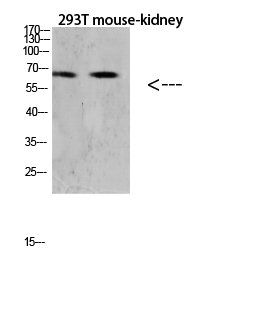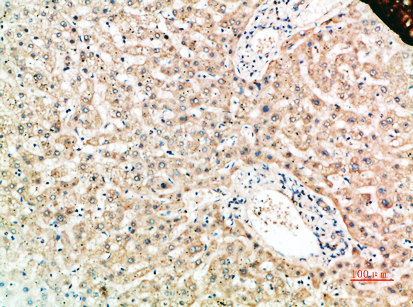产品名称
RANK Rabbit Polyclonal Antibody
别名
Tumor necrosis factor receptor superfamily member 11A (Osteoclast differentiation factor receptor;ODFR;Receptor activator of NF-KB;CD antigen CD265)
蛋白名称
Tumor necrosis factor receptor superfamily member 11A (Osteoclast differentiation factor receptor) (ODFR) (Receptor activator of NF-KB) (CD antigen CD265)
存储缓冲液
Liquid in PBS containing 50% glycerol, 0.5% BSA and 0.02% New type preservative N.
Human Gene Link
http://www.ncbi.nlm.nih.gov/sites/entrez?db=gene&term=8792
Human Swissprot No.
Q9Y6Q6
Human Swissprot Link
http://www.uniprot.org/uniprotkb/Q9Y6Q6/entry
Mouse Swissprot No.
O35305
Mouse Swissprot Link
http://www.uniprot.org/uniprot/O35305
免疫原
Synthetic peptide from human protein at AA range: 60-120
特异性
The antibody detects endogenous RANK
稀释度
WB 1:500-2000,IHC-p 1:500-200, ELISA 1:10000-20000. IF 1:50-200
宿主
Polyclonal, Rabbit,IgG
背景介绍
The protein encoded by this gene is a member of the TNF-receptor superfamily. This receptors can interact with various TRAF family proteins, through which this receptor induces the activation of NF-kappa B and MAPK8/JNK. This receptor and its ligand are important regulators of the interaction between T cells and dendritic cells. This receptor is also an essential mediator for osteoclast and lymph node development. Mutations at this locus have been associated with familial expansile osteolysis, autosomal recessive osteopetrosis, and Paget disease of bone. Alternatively spliced transcript variants have been described for this locus. [provided by RefSeq, Aug 2012],
组织表达
Ubiquitous expression with high levels in skeletal muscle, thymus, liver, colon, small intestine and adrenal gland.
细胞定位
[Isoform 1]: Cell membrane ; Single-pass type I membrane protein .; [Isoform RANK-e5a]: Cell membrane ; Single-pass type I membrane protein .
信号通路
Cytokine-cytokine receptor interaction;
功能
disease:Defects in TNFRSF11A are a cause of Paget disease of bone 2 (PDB2) [MIM:602080]; also known as familial Paget disease of bone. PDB2 is a bone-remodeling disorder with clinical similarities to FEO. Unlike FEO, however, affected individuals have involvement of the axial skeleton with lesions in the spine, pelvis and skull.,disease:Defects in TNFRSF11A are the cause of familial expansile osteolysis (FEO) [MIM:174810]. FEO is a rare autosomal dominant bone disorder characterized by focal areas of increased bone remodeling. The osteolytic lesions develop usually in the long bones during early adulthood. FEO is often associated with early onset deafness and loss of dentition.,disease:Defects in TNFRSF11A are the cause of osteopetrosis autosomal recessive type 7 (OPTB7) [MIM:612301]; also called osteoclast-poor osteopetrosis with hypogammaglobulinemia. Osteopetrosis is a rare genetic disease characterized by abnormally dense bone, due to defective resorption of immature bone. The disorder occurs in two forms: a severe autosomal recessive form occurring in utero, infancy, or childhood, and a benign autosomal dominant form occurring in adolescence or adulthood. OPTB7 is characterized by paucity of osteoclasts, suggesting a molecular defect in osteoclast development. OPTB7 is associated with hypogammaglobulinemia.,function:Receptor for TNFSF11/RANKL/TRANCE/OPGL; essential for RANKL-mediated osteoclastogenesis. Involved in the regulation of interactions between T-cells and dendritic cells.,similarity:Contains 4 TNFR-Cys repeats.,subunit:Interacts with TRAF1, TRAF2, TRAF3, TRAF5 and TRAF6.,tissue specificity:Ubiquitous expression with high levels in skeletal muscle, thymus, liver, colon, small intestine and adrenal gland.,
纯化
The antibody was affinity-purified from rabbit antiserum by affinity-chromatography using epitope-specific immunogen.


